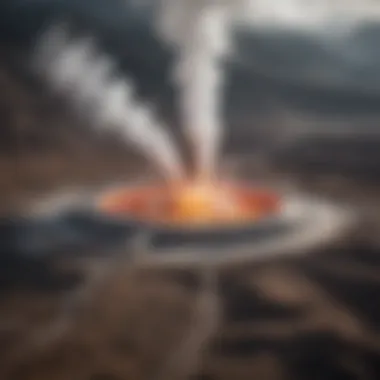Geothermal Energy: A Comprehensive Exploration


Intro
Geothermal energy stands out as a compelling alternative in the quest for sustainable power. This article examines its viability, technological advancements, and the implications for the environment and society. With global concerns over energy security and climate change, geothermal energy offers an intriguing solution. By tapping into the Earth's internal heat, it provides a steady and reliable source of power, lessening dependence on fossil fuels.
Research Highlights
Key Findings
Geothermal energy projects around the world have shown significant potential in reducing greenhouse gas emissions. Data indicate that using geothermal power can lead to up to 97% lower emissions compared to traditional coal-fired stations. This statistic underscores the value of further investment in geothermal technologies.
Moreover, advancements in drilling techniques and heat exchange systems have improved the efficiency and feasibility of geothermal plants. Enhanced geothermal systems (EGS) utilize advanced technology to extract heat from deeper sources, expanding the locations suitable for geothermal development.
Implications and Applications
The implications of geothermal energy extend beyond environmental benefits. Economically, it presents a stable energy price, insulated from the volatile nature of fossil fuel markets. Communities near geothermal sites often see job creation and infrastructure investment, leading to local economic growth.
Internationally, countries like Iceland and the Philippines have successfully implemented geothermal systems, showcasing its viability. These projects not only meet local energy needs but also contribute to energy independence.
Methodology Overview
Research Design
This article synthesizes data from various studies and reports on geothermal energy's effectiveness and environmental impact. A comprehensive review of published literature offers insights into the current state of geothermal technology and its applications.
Experimental Procedures
The methodologies employed in the referenced studies typically involve comparative analyses between traditional energy sources and geothermal systems. Measurements of efficiency, emissions, and economic impacts are prominently featured, providing a clear understanding of geothermal energy's efficacy.
The transition to geothermal energy requires coherent policies and investment strategies to integrate this resource into existing energy frameworks, maximizing its benefits.
Prolusion to Geothermal Energy
Geothermal energy is becoming increasingly relevant in discussions about sustainable energy sources. This section focuses on why it deserves attention and detailed exploration. Geothermal energy is the heat that comes from the Earth's core. It is a renewable source of energy, available constantly. This makes it a reliable alternative in an era when fossil fuels are declining and climate change is pushing for cleaner energy sources.
The benefits of geothermal energy include reduced greenhouse gas emissions and less air pollution. It does not depend on weather conditions, unlike solar or wind energy. This stability makes it attractive for energy production. Furthermore, geothermal technology can create jobs and stimulate economic activity, particularly in regions rich in geothermal resources.
Understanding geothermal energy is critical for students, researchers, and industry professionals. It is essential for informed decision-making about energy policy and development. As such, its applications can range from residential heating to large-scale power generation.
Definition and Overview
Geothermal energy refers to the thermal energy generated and stored in the Earth. The term derives from the Greek words 'geo' (earth) and 'therme' (heat). This energy is harnessed from various geological processes occurring beneath the Earth's surface. There are significant geothermal sources, including hot springs, geothermal reservoirs, and superheated steam found in volcanic regions.
Geothermal systems exploit the heat stored in the ground for various applications. These systems use the Earth’s stable subsurface temperatures for heating and cooling structures. The most common method is through geothermal heat pumps, which transfer heat from the ground into a building for heating or the reverse for cooling.
History of Geothermal Energy Use
The use of geothermal energy dates back thousands of years. Ancient cultures in regions like Italy and Japan used hot springs for bathing and cooking. In the modern era, the first commercial geothermal power plant began operation in 1904 in Lardarello, Italy. This plant generated electricity using steam from geothermal resources.
Since then, geothermal energy has evolved significantly. In the mid-twentieth century, several countries started investing seriously in geothermal technology. The United States became a leader in geothermal energy, with prominent sites such as The Geysers in California producing substantial amounts of electricity. Today, countries like Iceland, Philippines, and Indonesia also harness geothermal energy extensively.
This historical perspective shows the evolving understanding and utilization of geothermal resources. While it began as a simple means of harnessing heat, it has developed into a vital component for sustainable energy systems. The journey continues as technology improves, and the world looks for efficient energy solutions.
The Science Behind Geothermal Energy
The science of geothermal energy is crucial because it lays the foundation for understanding how we can harness the Earth's internal heat. This energy source, derived from the planet's core, manifests in various types, including hot springs and geothermal reservoirs. Understanding these sources is essential for evaluating the viability and efficiency of geothermal energy systems. Additionally, studying the heat extraction methods is critical in identifying the most effective ways to utilize this natural resource.
Geothermal Sources


Hot Springs
Hot springs are one of the most accessible forms of geothermal energy. They occur when groundwater comes into contact with hot rocks beneath the Earth's surface, heating the water to high temperatures. The key characteristic of hot springs is their natural occurrence and accessibility, often being found in geographical regions with volcanic activity. They serve as a sustainable and eco-friendly source for heating applications.
The unique feature of hot springs is their relatively low temperature compared to other geothermal sources. They generally range between 37°C to 90°C (98°F to 194°F). While they are beneficial for direct-use applications, like spas and swimming pools, their lower temperature limits their effectiveness for power generation. This presents both advantages, such as ease of access, and disadvantages, including inefficiency for electricity production.
Geothermal Reservoirs
Geothermal reservoirs represent an underground accumulation of hot water or steam that can be tapped for energy. A key characteristic of geothermal reservoirs is their ability to provide consistent and high-temperature energy, making them suitable for electricity generation. These reservoirs can be found at considerable depths, often requiring advanced drilling techniques to access.
A significant advantage of utilizing geothermal reservoirs is their high thermal energy potential, which can support large scale power plants. However, the initial investment and the risk of depleting the resource present notable challenges. The sustainability of these reservoirs depends largely on careful management and monitoring of the heat extraction process.
Superheated Steam
Superheated steam is a form of steam that has been heated beyond its boiling point. The key characteristic of superheated steam is its ability to drive turbines more efficiently than regular steam, contributing to superior energy production. In geothermal energy production, superheated steam is often sourced from deep underground reservoirs, making it particularly valuable.
The unique feature of superheated steam lies in its high temperature and pressure, which can lead to increased energy output. This makes it a beneficial choice for electricity generation. However, this higher efficiency also comes with challenges, including the need for specialized equipment to manage the extreme conditions safely.
Heat Extraction Methods
Heat extraction methods play a vital role in converting geothermal energy into usable forms. The effectiveness of these methods determines the overall efficiency of geothermal systems and their ability to contribute to the energy mix.
Geothermal Heat Pumps
Geothermal heat pumps are systems that transfer heat from the ground into buildings for heating and cooling. A key characteristic of geothermal heat pumps is their versatility. They can be used in various applications, including residential, commercial, and industrial settings. This versatility makes them a popular choice for energy-efficient climate control.
The unique feature of geothermal heat pumps is their ability to utilize stable underground temperatures. This leads to lowered energy consumption compared to traditional heating systems. Despite the benefits, the initial installation costs can be high, which may deter some potential users.
Enhanced Geothermal Systems
Enhanced Geothermal Systems (EGS) involve engineering processes to improve the productivity of geothermal reservoirs. The key characteristic of EGS is its ability to create reservoirs in locations where natural geothermal resources may be insufficient. This pairs well with the growing demand for sustainable energy solutions.
The notable feature of EGS is its adaptability in a variety of geological settings, thus broadening the potential for geothermal energy extraction. However, the geological unpredictability and associated costs present challenges. As research continues, EGS may emerge as a pivotal technology for the future of geothermal energy.
Geothermal Power Generation
Geothermal power generation plays a vital role in the discussion of sustainable energy sources. As a renewable energy solution, it harnesses the Earth’s internal heat to generate electricity. In comparison to fossil fuels, geothermal energy presents several advantages. It comes with a lower carbon footprint and provides a consistent energy output, which is crucial for energy stability. By utilizing this resource, countries can also reduce their dependency on imported fuels. Moreover, understanding how various geothermal power plants operate is essential to grasp the full potential of geothermal energy.
Types of Geothermal Power Plants
Dry Steam Plants
Dry steam plants represent the simplest form of geothermal power generation. They utilize steam directly from geothermal reservoirs.
- Key Characteristic: The direct use of steam makes these plants highly efficient.
- Benefits: They can generate electricity without intermediary heat exchange, resulting in lower operational costs.
- Unique Feature: Since they do not require any additional working fluid, these plants have a straightforward design.
- Advantages: Main advantages include reduced costs and minimal environmental impact. However, their use is limited to areas with high-temperature geothermal resources, which may restrict deployment in some regions.
Flash Steam Plants
Flash steam plants operate by taking high-pressure geothermal fluids from underground and "flashing" them into steam upon reaching the surface.
- Key Characteristic: These plants can utilize fluids at various temperatures, making them more adaptable than dry steam plants.
- Benefits: They can operate efficiently even with lower-temperature geothermal resources.
- Unique Feature: The capacity to use a mixture of steam and liquid offers flexibility in energy generation.
- Advantages: While effective across various geothermal sites, they do produce some greenhouse gases during operations.
Binary Cycle Power Plants
Binary cycle power plants are unique as they transfer heat from geothermal water to a secondary fluid, which vaporizes at a lower temperature. This method allows for harnessing geothermal resources that are not hot enough for steam generation.
- Key Characteristic: They utilize a closed-loop system, leading to zero emissions.
- Benefits: More inclusive of various geothermal temperatures, they enhance the viability of geothermal power.
- Unique Feature: The use of a secondary fluid minimizes environmental impact and increases efficiency at lower temperatures.
- Advantages: While they are often more complex and costly to build, their environmental benefits and ability to generate energy from lower-temperature resources position them as a favorable option for the future of geothermal energy.


Efficiency and Output Considerations
The efficiency and output of geothermal power generation depend on several factors. The temperature of the geothermal resource, the technology used, and the geographical location impact output levels significantly. It is crucial to assess these factors to optimize performance and energy production.
Current Geothermal Energy Projects
Current geothermal energy projects play a significant role in the landscape of sustainable energy solutions. These projects not only showcase the viability of harnessing geothermal resources but also highlight the diverse applications and innovative technologies within this field. By examining real-world examples, we can understand the potential benefits and the challenges faced in this sector. This knowledge is crucial for students, researchers, educators, and professionals who aim to engage with geothermal energy development.
Case Studies of Leading Projects
The Geysers, California
The Geysers in California represents one of the largest geothermal power complexes in the world. Spanning an area of around 45 square miles, it consists of multiple geothermal power plants that utilize steam generated from subterranean hot water reservoirs.
One of the key characteristics of The Geysers is its substantial production capacity, which can reach over 1,500 megawatts. This makes it a pivotal site in meeting California's energy demands. Its long-standing operation since the 1960s also provides valuable data on management practices and resource sustainability in geothermal energy extraction. This project is often praised for its efficiency and adequacy as a renewable energy source that contributes to reducing carbon emissions.
However, there are disadvantages linked with The Geysers, such as induced seismicity. It has been a subject of scrutiny regarding earth tremors that may arise from fluid extraction. Yet, ongoing studies are aimed at managing these risks while bolstering infrastructure and ensuring that The Geysers remains a productive entity for geothermal energy.
Reykjavik Geothermal, Iceland
Reykjavik Geothermal exemplifies Iceland's advanced use of geothermal energy. The company operates geothermal power plants that provide a remarkable percentage of the country’s electricity and heating needs. The hallmark feature of Reykjavik Geothermal is its focus on deep geothermal resources. This approach allows them to access hotter geothermal fluids, leading to higher efficiency in energy production.
Reykjavik Geothermal not only supplies power but also plays a critical role in providing district heating. This multitiered service enhances the value of geothermal energy in urban settings. The integrated system reduces the reliance on fossil fuels, exemplifying sustainability in practice.
Nonetheless, like The Geysers, Reykjavik Geothermal faces some challenges. The deep drilling required can be costly and technically demanding, a factor that poses risks for return on investment, especially in uncertain market conditions.
Innovative Approaches in Geothermal Energy
Innovative approaches are essential for the future of geothermal energy. Techniques such as enhanced geothermal systems and improved drilling technologies can increase the efficiency and accessibility of geothermal resources. Additionally, research into hybrid systems that combine geothermal with solar or wind energy is gaining attention.
As the sector evolves, partnerships between government, academia, and private industry are crucial. These collaborations encourage research and the development of new technologies. Investments in geothermal energy not only improve existing projects but also support the establishment of new facilities worldwide.
In summary, current geothermal energy projects showcase the depth of research, practical applications, and ongoing advancements in this field. Understanding these case studies and innovative approaches enhances our grasp of geothermal energy’s role in a sustainable future.
Environmental Impact of Geothermal Energy
Understanding the environmental impact of geothermal energy is crucial. This renewable energy source has the potential to provide significant benefits while also presenting specific risks. Geothermal energy harnesses heat from the Earth's interior, offering a cleaner alternative to fossil fuels. However, its implementation can lead to environmental considerations that need careful assessment. This section examines the sustainability and environmental benefits of geothermal energy, alongside potential environmental risks that arise from its use.
Sustainability and Environmental Benefits
Geothermal energy stands out for its sustainability. It provides a consistent and reliable electricity and heating source, available regardless of weather conditions. This constant availability makes geothermal energy an attractive choice for baseload power generation. It emits minimal greenhouse gases when compared to traditional fossil fuel sources, contributing to reduced carbon footprints. Furthermore, geothermal plants require less land than solar and wind farms, thus preserving more natural habitats.
Among the many benefits, geothermal energy promotes energy independence and security. By tapping into domestic geothermal resources, countries can reduce reliance on imported fuels. Additionally, geothermal developments can stimulate local economies through job creation in installation, maintenance, and management of energy systems.
Potential Environmental Risks
While geothermal energy presents many benefits, it is also associated with environmental risks, which include land use changes and induced seismicity.
Land Use Changes
Land use changes refer to the modifications in land patterns due to geothermal development projects. Developing geothermal plants can require accessing natural areas, which often results in habitat fragmentation. This alteration may displace local flora and fauna, impacting biodiversity. However, the smaller footprint of geothermal facilities compared to other renewable sources is noteworthy. The benefit here is that geothermal development can often integrate with existing land uses.
Changes in land use are a significant consideration because they can influence ecosystems and water systems. It is essential to conduct thorough environmental assessments prior to the establishment of geothermal projects, ensuring the preservation of essential ecological balances.
Induced Seismicity
Induced seismicity refers to earthquakes that occur as a result of human activities, such as geothermal energy extraction. The injection or withdrawal of fluids in the Earth's crust during geothermal operations can alter pressure levels and trigger seismic events. Although most induced earthquakes are small and not felt on the surface, they raise concerns about the stability of surrounding areas.


The management of induced seismicity is vital. Monitoring systems can track seismic activity and mitigate risks associated with geothermal power generation. Understanding the spatial distribution and magnitude of induced seismic activities is key to addressing public concerns and making informed decisions about geothermal energy projects.
"Geothermal energy has remarkable potential for sustainable development. However, it comes with challenges that must be managed responsibly."
Economic Aspects of Geothermal Energy
The economic facets of geothermal energy are critical in understanding its viability as a sustainable power source. As the world faces pressing energy challenges, evaluating the economic implications of geothermal energy becomes essential. Economically viable geothermal projects can lead to reduced overall energy costs, enhance energy security, and provide a stable return on investment over time. Key economic considerations include the initial capital investment, long-term operational costs, and the structure of government incentives that can ease the financial burden on developers.
Cost Analysis of Geothermal Projects
Analyzing costs for geothermal projects reveals various factors that affect the overall economics.
- Capital Investments: The initial setup of geothermal power plants often requires substantial funding. This includes drilling, infrastructure, and technology procurement. The average cost can vary significantly based on the resource integrity and location.
- Operating Expenses: Geothermal plants tend to have lower operating costs compared to conventional energy systems. The maintenance expenses are generally predictable and can be more manageable over time, leading to long-term savings.
- Expected Returns: While upfront capital can be daunting, geothermal projects often offer competitive returns on investment. Energy generated might be sold through power purchase agreements that enhance financial predictability.
- Risk Assessment: The financial risk is significant in geothermal projects. Factors such as resource assessment, drilling success rates, and market prices must be understood. Risk mitigation strategies include thorough geological surveys and creating partnerships with experienced entities.
- Cost Comparison: Comparing costs across various energy sources, geothermal stands out as reliable due to its ability to provide base-load power. The cost per megawatt-hour for geothermal energy can be competitive, especially when compared to fossil fuels and even other renewables under certain conditions.
"A well-planned geothermal project can substantially reduce electricity prices, benefiting not only the producers but also the consumers."
Government Policies and Incentives
Government policies play a vital role in the economic landscape of geothermal energy. Various incentives aim to stimulate investment and promote growth in the sector.
- Subsidies and Grants: Direct financial support from governments can lower the investment risk faced by developers. Many nations offer subsidies or grants for research and development in geothermal technology, providing a necessary financial cushion.
- Tax Benefits: Tax incentives at both federal and state levels can offset initial project costs. Investors may deduct certain expenses, enhancing the attractiveness of geothermal initiatives.
- Feed-in Tariffs: Some areas implement feed-in tariffs that guarantee fixed payments to geothermal operators for the electricity generated. This predictability can aid in securing financing for projects.
- Regulatory Frameworks: Clear regulations help encourage investment by reducing uncertainty. These can protect the rights of developers regarding access to geothermal resources, thereby fostering growth in this sector.
- International Collaboration: Several governments are collaborating on geothermal energy projects and sharing knowledge. This can facilitate technology transfer and enhance the economic viability of projects in various parts of the world.
In summary, the economic landscape surrounding geothermal energy is complex but promising. With supportive policies and sound economic planning, geothermal energy can significantly contribute to a sustainable energy future.
Future of Geothermal Energy
The future of geothermal energy holds significant promise as the world shifts towards more sustainable energy solutions. This section aims to explore how innovations in technology and changing energy demands make geothermal energy a vital part of global energy transition strategies. Geothermal energy can provide a consistent and reliable power source with minimal environmental footprint. As a result, it is increasingly recognized for its potential role in achieving energy resilience and sustainability.
Technological Innovations
Technological advancements are reshaping the geothermal energy landscape. New techniques are allowing for better heat extraction and increasing the overall efficiency of geothermal systems. For instance, the development of Enhanced Geothermal Systems (EGS) enables heat extraction from areas previously deemed unviable. Key innovations include:
- Improved drilling technologies: Advancements in drilling methods reduce costs and time required to access geothermal resources.
- Advanced geothermal heat pumps: These systems are more effective at transferring heat to and from the ground, enhancing energy efficiency.
- Smart grid integration: Connecting geothermal plants to smart grids allows for better management of energy supply and demand dynamics.
These innovations are crucial not only for increasing geothermal output but also for integrating this energy source into existing energy infrastructures. As technologies continue to develop, their cost-effectiveness will likely improve, making geothermal energy more accessible and widespread.
Geothermal Energy's Role in Energy Transition
Geothermal energy will play a pivotal role in the global transition towards low-carbon energy systems. It complements other renewable energies, providing a stable base load power supply that can operate independently of weather conditions. Benefits of geothermal energy in this context include:
- Consistent reliability: Unlike solar and wind, geothermal plants do not depend on environmental factors for consistent power generation.
- Lower greenhouse gas emissions: As a clean energy source, geothermal power significantly reduces carbon emissions compared to fossil fuels.
- Economic resilience: Investing in geothermal energy creates jobs and supports local economies, contributing to energy independence.
"Geothermal energy is an essential component of a balanced energy portfolio, ensuring reliability while minimizing environmental impact."
By leveraging these advantages, geothermal energy's integration into energy policies can facilitate smoother transitions to renewable sources. Overall, the future of geothermal energy is an optimistic one, marked by ongoing technological progress and valuable contributions to sustainable energy goals.
Epilogue
In this article, we have investigated the significant role geothermal energy plays in the current energy landscape. The conclusion serves as a synthesis of the insights gathered throughout our exploration. Understanding geothermal energy's effectiveness as a sustainable resource is essential in addressing energy demands.
Summary of Findings
Geothermal energy represents a reliable and constant source of power, unlike other renewable resources. We explored different generating technologies, including dry steam, flash steam, and binary cycle plants. These systems utilize the heat from the Earth effectively.
Moreover, we reviewed current projects which showcase successful implementations, such as The Geysers in California and Reykjavik Geothermal in Iceland. Each case study highlights the impact and viability of geothermal production on a global scale. The environmental benefits outlined demonstrate geothermal's lower greenhouse gas emissions compared to conventional energy sources. Yet, we also recognized potential risks including land use changes and induced seismicity, further underscoring the need for careful management and research.
Recommendations for Future Research
Future investigations should focus on enhancing the efficiency of geothermal systems. Exploring advanced technologies, like enhanced geothermal systems and improved heat extraction methods, could play an essential role in increasing applicability. Furthermore, understanding the regional geological characteristics can help identify new geothermal resources.
Collaboration among government bodies, researchers, and industry leaders will drive innovation. Policies and incentives must support investment in this sector. Therefore, we suggest further studies concentrate on economic models that include lifecycle cost assessments and public acceptance factors. These elements are crucial in promoting geothermal energy as a competitive alternative in the global energy market.
A comprehensive approach toward geothermal development can yield significant advantages for sustainable energy production.



